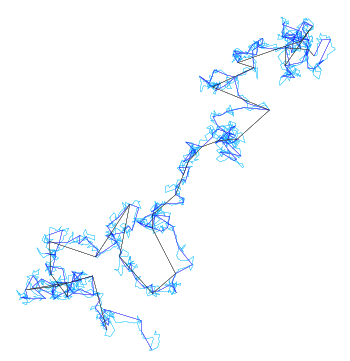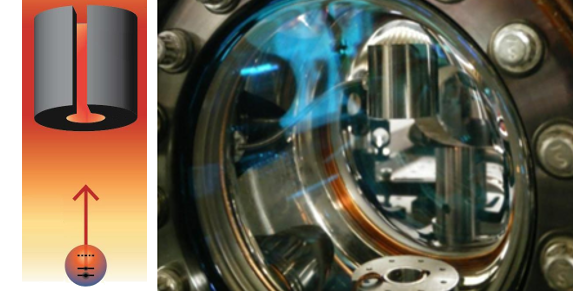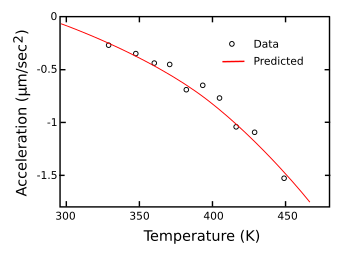Hot Attraction
February 5, 2018
Forces acting at a distance have been commonplace in
physics for hundreds of years, and because of their familiarity, they have lost their air of
mystery. Presently, these forces are viewed as the consequence of a mediating
field that carries
energy and
momentum across
space.
charges and
magnets interact with the
electromagnetic field and change it, thus producing the forces that we see. So, these mysterious forces have been replaced by the mystery of the field. It's "
turtles all the way down."
Pliny the Elder (23-79 A.D.), whom I mentioned in numerous articles, wrote about the mystery of
magnetism in Book XXXVI of his
Natural History.
A marmoribus degredienti ad reliquorum lapidum insignes naturas quis dubitet in primis magnetem occurrere? quid enim mirabilius aut qua in parte naturae maior inprobitas?[1]
Upon quitting the marbles to pass on to the other more remarkable stones, who can for a moment doubt that the magnet will be the first to suggest itself? For what, in fact, is there endowed with more marvellous properties than this?[2]
Moving forward 400 years,
St. Augustine of Hippo (354-430) expressed a similar amazement in his book,
The City of God,
Magnetem lapidem nouimus mirabilem ferri esse raptorem; quod cum primum uidi, uehementer inhorrui. Quippe cernebam a lapide ferreum anulum raptum atque suspensum; deinde tamquam ferro, quod rapuerat, uim dedisset suam communemque fecisset, idem anulus alteri admotus est eundemque suspendit, atque ut ille prior lapidi, sic alter anulus priori anulo cohaerebat; accessit eodem modo tertius, accessit et quartus; iamque sibi per mutua circulis nexis non implicatorum intrinsecus, sed extrinsecus adhaerentium quasi catena pependerat anulorum. Quis istam uirtutem lapidis non stuperet, quae illi non solum inerat, uerum etiam per tot suspensa transibat et inuisibilibus ea uinculis subligabat?
We know that the lodestone has a wonderful power of attracting iron. When I first saw it I was thunderstruck, for I saw an iron ring attracted and suspended by the stone; and then, as if it had communicated its own property to the iron it attracted, and had made it a substance like itself, this ring was put near another, and lifted it up; and as the first ring clung to the magnet, so did the second ring to the first. A third and a fourth were similarly added, so that there hung from the stone a kind of chain of rings, with their hoops connected, not interlinking, but attached together by their outer surface. Who would not be amazed at this virtue of the stone, subsisting as it does not only in itself, but transmitted through so many suspended rings, and binding them together by invisible links?
.png)
St. Augustine of Hippo (354-430) was a Christian theologian and philosopher and the bishop of Hippo Regius in North Africa. His writings were important enough to have him declared a Doctor of the Church, and a saint whose feast day is August 28, the day of his death.
Augustine had a dim view of astrology, which was a respected science of his era.
(Circa 1472-1473 portrait of St. Augustine of Hippo (354-430), tempera on panel, by Antonello da Messina (1430–1479), sited at the Galleria Regionale della Sicilia, via Wikimedia Commons)
As we fast-forward more than a
millennium, we find that action at a distance is still considered to be a mystery. As
Isaac Newton (1642-1727) wrote concerning gravity in a letter to
Richard Bentley,
It is inconceivable that inanimate brute Matter, should, without the mediation of something else, which is not material, operate on and affect other Matter without mutual Contact, as it must be, if Gravitation in the sense of Epicurus, be essential and inherent in it. And this is one Reason why I desired you would not ascribe innate Gravity to me. That Gravity should be innate, inherent and essential to Matter so that one Body may act upon another at a Distance thro' a Vacuum, without the Mediation of any thing else, by and through which their Action and Force may be conveyed, from one to another, is to me so great an Absurdity, that I believe that no Man who has in philosophical Matters a competent Faculty of thinking, can ever fall into it. Gravity must be caused by an Agent acting constantly according to certain Laws; but whether this Agent be material or immaterial, I have left for the Consideration of my Readers.[5]
As I wrote in a
previous article (Depletion Attraction, March 7, 2011), even
non-fundamental forces can be mysterious. There's an unusual attractive force between large
particles called
depletion attraction when they're in
solution with smaller particles. Since two particles in solution can't occupy the same space at the same time, and one large particle can take the place of many smaller particles,
surface effects become important, and the many small
spheres filling the same
volume as one larger sphere will have a larger
surface area exposed to the solution.
Polymer scientists, Sho Asakura and Fumio Oosawa, discovered this force that's not a consequence of
electrostatic attraction in 1958.[6] Small particles in solution can't access the space between closely spaced large particles, so they push the larger particles towards each other. The
free energy change ΔF of this
thermodynamic effect is described for
elastic spheres by the simple
equation,[7]
ΔF ≈ n kB T [1 + 3/2(D/d)]
in which
D and
d are the
diameters of the larger and smaller spheres,
T is
temperature,
kB is
Boltzmann's constant,
n is the
volume fraction of small spheres, and
(1-n) is the volume fraction of large spheres.

Heraclitus of Ephesus (c.535-c.475 BC) wrote that everything flows (παντα ρει), which might be paraphrased as everything moves.
This is shown by the Brownian motion of particles in solution, caused by another mysterious force discovered in 1827 by botanist, Robert Brown.
On an even smaller scale, there's the Zitterbewegung, the trembling motion of the position of electrons at an angular frequency of 2mc2/h, approximately 2.5465 x 1020 hertz, in which m, c, and h are respectively the electron mass, the speed of light, and the Planck constant.
(Modified Wikimedia Commons image showing computed Brownian motion at three hierarchical scales.)
Another mysterious force has been revealed in a recent
open access paper in
Nature Physics.[8-9] The hitherto unknown attraction of atoms to a hot
blackbody radiator with a force about an
order of magnitude greater than
gravitation has been studied by an international team of
physicists from the
University of California (Berkeley, California),
Lawrence Berkeley National Laboratory (Berkeley, California), the
University of Glasgow (Glasgow, UK), the
Medical University of Innsbruck (Innsbruck, Austria), and the
University of Innsbruck (Innsbruck, Austria).[8]
The expected
phenomenon is repulsion, not attraction. Bodies at any
temperature above
absolute zero emit
radiation that exerts a small
pressure on neighboring objects. However, a
cesium atom at
room temperature will intercept less than a single movement-inducing
photon in a 100 million years, so this effect is negligible.[8] Atoms, however, will also interact
coherently with the thermal
electromagnetic field, and an attractive effect was
conjectured a few years ago.[9] This is the non-coherent
analog of the coherent
laser beams used as
optical tweezersoptical tweezers for trapping atoms.[9]
As you can imagine, measurement of such small forces takes a bit of
experimental finesse.[10] To measure the attractive force of the blackbody radiation between a cesium atom and a
heated,
centimeter-sized,
cylinder, the research team used
atom interferometry.[8] The cesium atoms were
laser-cooled to about 300
nanokelvin and launched upwards into
free fall in an
atomic fountain, and half of them reached 3.7
millimeter into the cylinder at their
apex.[8-9] These interacted with the atoms not affected by the cylinder to cause a detected
phase shift, allowing
calculation of the attractive force.[9]

Experimental concept (left) and the experimental apparatus (right). In the right image, the shiny tungsten cylinder can be seen at top through the vacuum chamber window. (Left image and right image by Holger Müller, UC Berkeley.
It was found that the force, which was in good agreement with
theory, scaled as the
fourth power of the cylinder temperature over a large temperature range (see graph).[8] While this attraction is twenty times the gravitational attraction, it's still very small.[9] Says
Victoria Xu, a
co-author of the study and a
graduate student in the
UC Berkeley physics department,
"It's hard to find a scenario where this force would stand out... It is not clear it makes a significant effect anywhere. Yet... People think blackbody radiation is a classical concept in physics - it was a catalyst for starting the quantum mechanical revolution 100 years ago - but there are still cool things to learn about it."[9]

Acceleration of the cesium atoms as a function of the temperature of the cylinder, showing a fourth power temperature-dependence. The data points are the averages of 65 measurements.
(Created using Inkscape from data in ref. 8.[8])
While the effect is small, correction for it might be needed in using high precision atom interferometers in searches for
dark matter and
dark energy, and
gravitational wave detection using lab-scale instruments instead of kilometer-long
interferometers such as
LIGO.[8-9] This research was funded by the
David and Lucile Packard Foundation, the
National Science Foundation, the
Defense Advanced Research Projects Agency, and the
National Aeronautics and Space Administration.[9]
References:
- Pliny the Elder: the Natural History, Book XXVI, from Bill Thayer's Penelope Web Site at the University of Chicago.
- Pliny the Elder, The Natural History, Book XXXVI. The Natural History Of Stones, Chap. 25, The Magnet: Three Remedies, English Translation by John Bostock and H.T. Riley, Project Perseus Web Site at Tufts University.
- Aurelius Augustinus, De civitate Dei, Liber XXI, pp. 412-426, via Wikisource.
- St. Augustine's City of God and Christian Doctrine, Chapter 4, Examples from Nature Proving that Bodies May Remain Unconsumed and Alive in Fire, Christian Classics Ethereal Library.
- Isaac Newton, Letter III from "Four letters from Isaac Newton to doctor Bentley, containing some Arguments in Proof of a Deity," 1756, p. 25f., via Google Books.. Also at The Newton Project.
- Sho Asakura and Fumio Oosawa, "Interaction between particles suspended in solutions of macromolecules," Journal of Polymer Science, vol. 33, no. 126 (December, 1958), pp. 183-192.
- Davide Marenduzzo, Kieran Finan and Peter R. Cook, "The depletion attraction: an underappreciated force driving cellular organization," J Cell Biol., VOL. 175, NO. 5 (December 4, 2006), PP. 681-686
- Philipp Haslinger, Matt Jaffe, Victoria Xu, Osip Schwartz, Matthias Sonnleitner, Monika Ritsch-Marte, Helmut Ritsch, and Holger Müller, "Attractive force on atoms due to blackbody radiation," Nature Physics (December 4, 2017), doi:10.1038/s41567-017-0004-9. This is an open-access paper with a PDF file available here.
- Robert Sanders, "Hot bodies are attractive," University of California - Berkeley Press Release, December 8, 2017.
- Interestingly, finesse is also an optical term used to describe a Fabry–Pérot interferometer.
Linked Keywords: Action at a distance; forces acting at a distance; physics; mystery; field; energy; momentum; space; electric charge; magnet; fundamental interaction; electromagnetic field; turtles all the way down; Pliny the Elder (23-79 A.D.); magnetism; Natural History (Pliny); marbles; stone; St. Augustine of Hippo (354-430); The City of God (book); lodestone; iron; ring; chain; Christian; theology; theologian; philosopher; bishop; Hippo Regius; North Africa; writing; Doctor of the Church; saint; calendar of saints; feast day; death; astrology; science; Antonello da Messina (1430–1479); Galleria Regionale della Sicilia; Wikimedia Commons; millennium; Isaac Newton (1642-1727); gravity; Richard Bentley; animacy; inanimate; matter; material; Newton's law of universal gravitation; Epicurus; itrinsi; innate, inherent; vacuum; absurdity; human; man; philosophy; philosophical; thought; faculty of thinking; agent; physical law; depletion attraction; fundamental interaction; particle; solution; surface; sphere; volume; surface area; polymer science; polymer scientist; Coulomb's law; electrostatic attraction; Gibbs free energy; thermodynamics; thermodynamic; elastic collision; elastic; equation; diameter; temperature; Boltzmann's constant; volume fraction; Heraclitus of Ephesus (c.535-c.475 BC); panta rhei; everything flows; paraphrase; Brownian motion; force; botany; botanist; Robert Brown; Zitterbewegung; electron; angular frequency; hertz; electron mass; speed of light; Planck constant; hierarchy; hierarchical; open access journal; open access paper; Nature Physics; blackbody; electromagnetic radiator; order of magnitude; gravitation; physicist; University of California (Berkeley, California); Lawrence Berkeley National Laboratory (Berkeley, California); University of Glasgow (Glasgow, UK); Medical University of Innsbruck (Innsbruck, Austria); University of Innsbruck (Innsbruck, Austria); phenomenon; absolute zero; electromagnetic radiation; pressure; cesium; atom; room temperature; photon; coherence; electromagnetic field; conjecture; conjectured; analogy; analog; laser; optical tweezers; experiment; experimental; heat; heated; centimeter; cylinder; atom interferometry; laser cooling; laser-cooled; nanokelvin; free fall; atomic fountain; millimeter; apex; phase shift; calculation; tungsten; vacuum chamber; window; theory; fourth power; Victoria Xu; co-author; postgraduate education; graduate student; UC Berkeley physics department; scenario; classical physics; quantum mechanics; quantum mechanical; acceleration; cesium; atom; function; data; average; Inkscape; dark matter; dark energy; gravitational wave; interferometry; interferometer; LIGO; David and Lucile Packard Foundation; National Science Foundation; Defense Advanced Research Projects Agency; National Aeronautics and Space Administration.